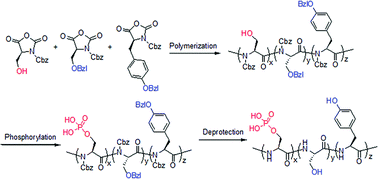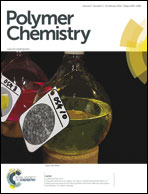Synthesis of biomimetic co-polypeptides with tunable degrees of phosphorylation†
Abstract
Phosphorylated polypeptides represent promising biomimetic macromolecules for various regenerative applications. However to date, large-scale synthesis of phosphorylated polypeptides with controlled degrees of phosphorylation has not been achieved, restricting research in phosphorylated proteins to their central roles in biomineralization pathways. Here, we present a co-polypeptide synthesis strategy based on the Ring-Opening Polymerization (ROP) of N-carboxyanhydrides (NCAs), followed by controlled phosphorylation of serine (Ser) residues. The molecular design, including amino acid composition and molecular weight of polypeptides, mimicked the intriguing phosphorylated protein Pc-3 secreted by the sandcastle tube worm Phragmatopoma californica, which is a major constituent of the glue produced by the animal to bind hard particles together for their protective tubes. Pc-3 is comprised of mostly Ser and tyrosine (Tyr), with up to 70% of Ser residues phosphorylated into phospho-serine (pSer) giving rise to the high net negative charge of Pc-3. Three NCA monomers were synthesized, namely Ser with free –OH groups, and Ser and Tyr with protected –OH groups, and subsequently polymerized with various feeding ratios in order to obtain a broad range of final amino acid compositions. In the final step, phosphorylation targeting free –OH groups of Ser was conducted. With this strategy, the degree of phosphorylation is governed by the initial amount of unprotected –OH groups of the precursor Ser–NCA, and the final co-polypeptides contain relative amounts of Tyr and pSer that can be tailored, yielding a composition and molecular weight (MW) that closely match those of Pc-3. This control of phosphorylation leads to polypeptides exhibiting a wide range of zeta potential values between −20 and −50 mV. Using analytical assays, including Dynamic Light Scattering (DLS), Surface Plasmon Resonance (SPR), and Quartz Crystal Microbalance with Dissipation (QCM-D), we demonstrate that these phosphorylated polypeptides exhibit affinity towards divalent ions such as Ca2+, thus opening the door for their usage as scaffolds for mineralized tissue repair or as a major component of biocompatible adhesives.


 Please wait while we load your content...
Please wait while we load your content...